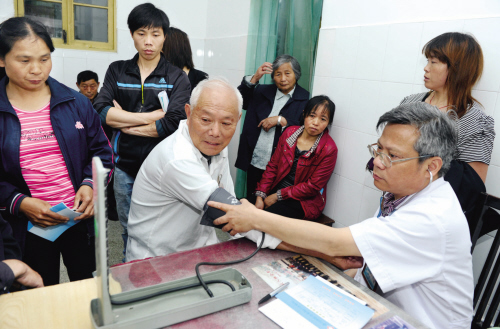Healthcare reform rolls on: What's next?
- By Liu Qiang
 0 Comment(s)
0 Comment(s) Print
Print E-mail China.org.cn, November 10, 2013
E-mail China.org.cn, November 10, 2013
|
|
|
Since 2009, China has accelerated its reforms to make health care more accessible and affordable. By 2013, medical insurance has covered 95 percent of the population. [File Photo] |
At the 18th National Congress of the Communist Party of China (CPC) last November, China pledged to advance the nation’s medical insurance system to one that covers the entire population, as well as establish a mechanism to provide insurance and aid in treating critical illnesses. As the Third Plenary Session of the 18th CPC Central Committee opened this Saturday, people are expecting the meeting will charter the next stage for China’s healthcare reform.
Reform rolls forward
Since 2009, China has accelerated its reforms to make health care more accessible and affordable. By 2013, medical insurance covered 95 percent of the population, with 265 million people enrolled in the Basic Medical Insurance for Urban Employees (BMIUE), 271 million covered by the Basic Medical Insurance for Urban Residents (BMIUR) and 805 million enrolled in the New Rural Cooperative Medical Insurance Scheme (NRCMS).
As the Report of the 18th National Congress of the CPC pointed out, everyone should have access to basic medical and public health services. By 2015, the percentage of people covered by medical insurance will have increased by 3 percent.
Despite the universal coverage, public dissatisfaction with the health service is growing. We have seen a rising number of attacks on medical staff across China. According to figures from the Chinese Hospital Association, from 2008 to 2012, the number of incidents aimed at doctors and nurses per year increased from 20.6 to 27.3 on average in every hospital across China. Doctors and nurses are experiencing a crisis, and so is patient-doctor trust.
Violence has become an expression of the patients’ resentment over the high costs of treatment and medicine, as well as over corruption. The semi-marketization reform has left China’s public hospitals struggling to make ends meet. To boost salaries, doctors are forced to over-prescribe medicines and tests, and even receive grey incomes -- kickbacks from medicine companies.
In July this year, GSK’s China business was probed for allegations of bribing doctors to boost sales. In an effort to end their financial dependence on medicine, authorities have since last June started reforms at county-level public hospitals to wean hospitals away from medicine. Reforms are expected to be extended to all public hospitals by 2015.
As healthcare coverage has broadened, the share of patient spending has also declined dramatically. The NRCMS pays for 75 percent of in-patients’ costs once they are admitted to hospital and the BMIUR covers 70 percent. Yet challenges remain daunting as the high proportion of reimbursement may not be of much help to those patients suffering critical illnesses.
When addressing the 16th National Congress of the All-China Federation of Trade Unions on Oct. 21, Premier Li Keqiang emphasized the importance of establishing a critical illness coverage system. “There are 3 million people every year who can’t afford to pay for the bills when diagnosed with critical conditions despite the reimbursement,” he pointed out.
Serious health expenses dragging a household into poverty is nothing unusual, especially not among low and middle income families who are particularly vulnerable to critical illnesses. The Guiding Opinions on Providing Critical Illness Insurance for Urban and Rural Residents co-drafted by six Ministries was released at the end of last August. According to the Opinions, those insured by BMIUE, BMIUR or NRCMS will get at least half of the self-paid treatment expenses reimbursed once diagnosed with severe illness.
By the end of August 2013, 94 regions across 23 provinces had piloted the critical illness cover system and seven provinces had fully implemented the system, benefiting 210 million people. Patients with grave illnesses including uremia and cervical cancer have been reimbursed for 90 percent of the total costs in some regions.
What is next?
In October, Russia announced that all Russians will enjoy free healthcare. The announcement aroused a debate over whether China can follow in Russia’s footsteps. Professor Zhou Zijun of School of Public Health, Peking University, opposed this idea. “Free healthcare for low-income groups is feasible, but free healthcare for all is impossible in China. It will put unbearable economic burdens on younger generations.”
When talking about the critical illness cover system, Li said, “To explore solutions for this problem, the government along with society and its individuals should work together.” As China’s healthcare reform rolls forward, the country’s total health expenditure has ballooned. Complete reliance on the government and public hospitals may not be an ideal option in China.
At the 18th National Congress of the CPC, China renewed its health policies and for the first time the Report explicitly stated, “We should encourage the development of private hospitals.” Fortunately, we don’t have to wait much longer to welcome a major breakthrough in this area.
On September 29, 2013, the China (Shanghai) Pilot Free Trade Zone was launched and the establishment of wholly foreign-owned medical institutions will be allowed within the Zone. Although the government is not making much bolder moves, it is still good news for China’s patients. It may still be too early to say that China’s public hospitals will be challenged, but at least we can expect more foreign funding will be poured into China’s medical sector. Now that the door has been opened, who knows what will come next?






